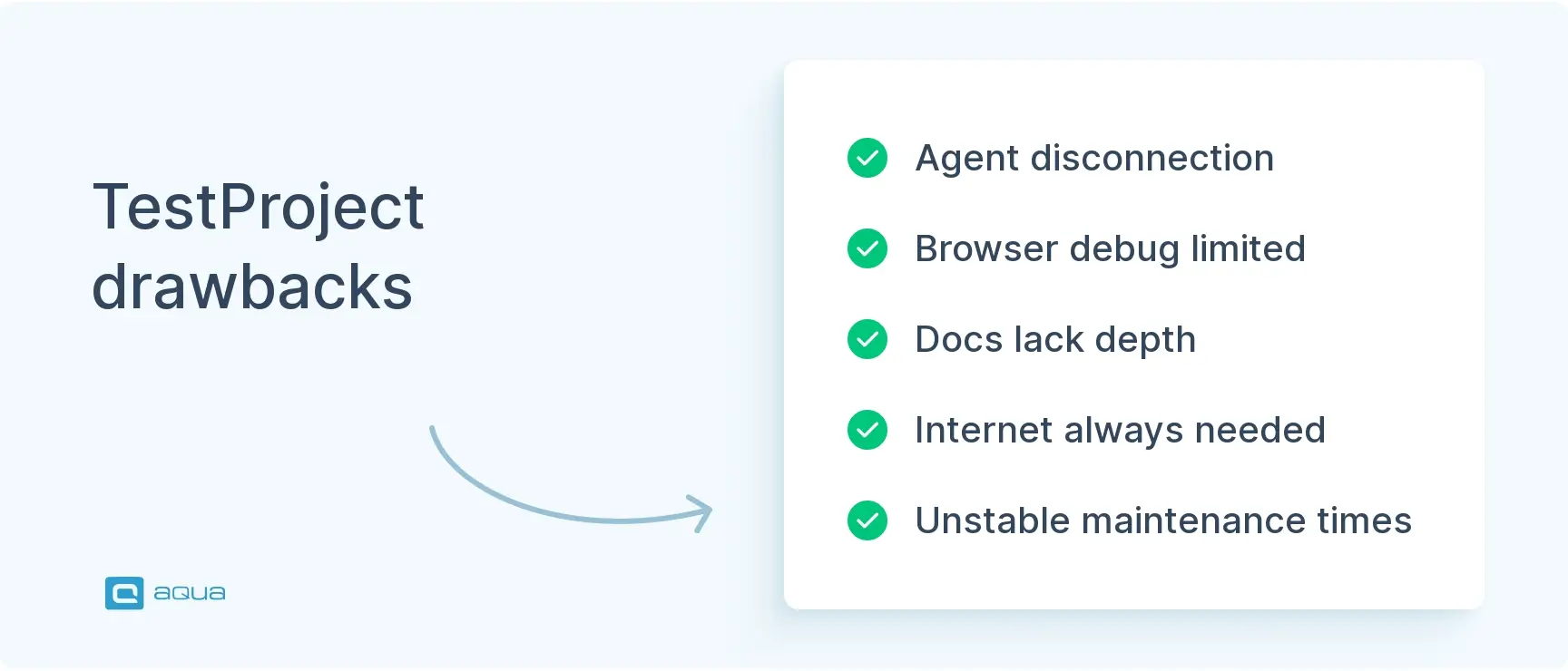Key takeaways
- TestProject is a free, community-powered test automation platform built on Selenium and Appium, serving 150,000 users worldwide with codeless automation capabilities.
- The platform’s codeless approach and multi-platform support (web, mobile, API) make it accessible to teams without extensive programming expertise, reducing onboarding time from weeks to days.
- Agent disconnection issues represent the most critical technical challenge, with users reporting persistent connectivity problems that cause test failures even after relaunching the agent.
- Support quality has declined significantly following Tricentis acquisitions, transforming from “best I’ve ever experienced” to frequent complaints about unannounced maintenance and slow responses.
- While the free pricing model attracts many users, reliability concerns and technical limitations raise questions about TestProject’s suitability for mission-critical testing environments.
Tired of expensive test automation tools that require extensive coding? TestProject offers free codeless automation for 150,000+ users, but reviews reveal persistent agent issues and support challenges. Discover what real QA teams experience with TestProject daily.👇
What Is TestProject
TestProject is essentially a concept of testing smarter with codeless automation. Or, in other words, ensuring every team member can create automated tests without extensive coding knowledge and that test automation is accessible throughout the development process rather than requiring specialized programming expertise.
The platform originated from Tricentis’s vision to democratize test automation and was launched in 2015, later acquired by Tricentis in 2019. In testing specifically, TestProject methodology focuses on identifying what truly adds value through community-powered solutions and eliminating the technical barriers that prevent teams from adopting automation.
As such, TestProject is characterized by several key attributes:
- It’s completely free with no subscription fees or feature limitations
- It provides codeless test creation through record-and-playback functionality
- It supports multiple platforms (web, mobile, API) in one unified solution
- It’s built on industry-standard Selenium and Appium frameworks
- It’s integrated with popular DevOps and CI/CD tools
For example, instead of writing extensive Selenium code upfront that requires programming expertise, TestProject allows users to simply click through applications while the platform automatically generates the automation code. Or rather than maintaining separate tools for web and mobile testing, a TestProject strategy provides a unified platform handling all testing needs.
TestProject is very easy to install and definitely, and it's so user-friendly, as it does not require any code-level experience, not even technology-related knowledge. And the functionality of Record and Play for testing is so super and comfortable compared to other software.
Comparison of TestProject and Traditional Automation Tools
Since you’ve already explored the TestProject concept, let’s compare it against traditional automation approaches for a complete insight:
| Aspect | Traditional Automation Tools | TestProject |
|---|---|---|
| Cost | Expensive licensing or significant setup effort | Completely free with no hidden costs |
| Technical Expertise | Requires programming knowledge and framework setup | Codeless approach accessible to non-developers |
| Platform Support | Often separate tools for web, mobile, and API | Unified platform for all testing types |
| Setup Time | Days or weeks for environment configuration | Minutes with cloud-based agent installation |
| Driver Management | Manual management of browser/device drivers | Automatic driver handling |
| Community Support | Varies by tool | Strong community with 150,000 users and addon ecosystem |
| Learning Curve | Steep for beginners | Minimal learning curve with intuitive interface |
| Infrastructure | Local setup and maintenance required | Cloud-based with minimal local requirements |
| Support Quality | Typically paid support tiers | Free but declining support quality reported |
| Reliability | Depends on implementation | Agent disconnection issues frequently reported |
The change from traditional automation to TestProject means changing how you think about test creation. Testers know well that traditional approaches require significant coding skills and infrastructure management. TestProject, on the other hand, prioritizes accessibility and quick setup, though this comes with trade-offs in reliability and support.
Why TestProject User Experiences Matter
After seeing how TestProject differs from traditional approaches, you might wonder if the platform delivers on its promises. Let’s look at what actually happens when teams adopt this tool.
Picture your current automation journey. How long does it take to get team members productive with Selenium? Weeks, or maybe even months? TestProject changes this equation. You can record tests without coding and leverage community addons for extended functionality. As for the result: Users report getting team members “up and running within days rather than weeks.”
The cost implications are equally significant. Traditional automation often involves substantial licensing fees or extensive development time. TestProject works differently. With this platform, you invest zero dollars upfront and focus on building tests rather than frameworks.
But here’s what may come as a surprise: TestProject’s free model actually introduces different challenges rather than eliminating all problems. That’s because you’re dealing with reliability issues that affect production testing schedules. According to user reviews across G2 and Capterra, agent disconnection is the most frequently cited technical issue.
The concerning part is that these challenges compound over time. Agent disconnections disrupt scheduled test runs. Support quality has declined following acquisitions. Due to that, teams lose confidence in their ability to rely on the platform for critical testing. This sets the stage for the next critical question: what exactly works well and what struggles in TestProject?
When you evaluate TestProject, the right expectations make the difference between satisfaction and frustration. That’s where aqua cloud’s test management platform provides an alternative approach. While TestProject users deal with agent disconnections and maintenance windows, aqua’s cloud-native architecture delivers zero downtime and consistent performance. The platform centralizes manual and automated tests in one location with 100% traceability linking every test case to requirements and defects in real time. Moreover, aqua’s AI Copilot generates complete test cases from requirements, documentation, or even voice notes in just 3 clicks. Unlike TestProject’s declining support, aqua delivers responses in under 2 hours from engineers with 20 years of testing expertise. With 10+ native integrations including Jira, Azure DevOps, and Selenium, you get enterprise capabilities without the complexity of stitching together multiple tools.
Save 97% time on your test case creation efforts with AI-powered automation
Features & Functionality: What Users Loved and What They Struggled With
The Codeless Automation Promise
Through our analysis of user feedback, we found that TestProject’s approach to codeless automation consistently receives praise, particularly for teams without extensive programming backgrounds. The record-and-playback feature was frequently mentioned as a major selling point, allowing testers to create automated tests simply by clicking through their applications.
This accessibility made TestProject attractive to organizations transitioning from manual to automated testing. Many reviewers noted they could get team members up and running within days rather than weeks.
One stop for all sorts of automation: web, mobile, and API. Recording feature is awesome and scheduled tests are another great feature. It doesn't require any prior knowledge to work with; it's just plug and play.
Multi-Platform Support
Users appreciated TestProject’s ability to handle web, Android, iOS, and API testing from a single platform, a rare feature in the market at that time. The unified approach simplified workflows for teams managing complex testing across multiple environments.
With TestProject we can automate web, mobile, and API. It has good record and playback features and can be easily used by someone who does not have much knowledge of coding. The UI interface is very easy and comfortable to use.
Performance Limitations and Technical Issues
However, our research into user experiences revealed several persistent technical problems that impacted their daily work:
Agent Disconnection Problems: This was the most frequently cited technical issue across all review platforms. Users reported that the TestProject agent would disconnect unexpectedly, even after relaunching, causing test failures and workflow disruptions.
Many times TestProject agent remains disconnected even if you relaunch the agent. If your device gets turned off or due to a network issue the agent gets disconnected, then the job will fail as there is no solution available for it.
Not a significant dislike I have found, but I have seen multiple times that TestProject agents get disconnected; this can be fixed in upcoming updates. More and easier support options are required.
At aqua, we understand how frustrating these disruptions can be. While TestProject users report frequent agent disconnections and unexpected downtime that disrupt testing workflows, aqua cloud delivers the reliability that testing teams need. What truly transforms your workflow is aqua’s domain-trained AI Copilot that generates complete test cases from requirements, documentation, or even voice notes in just 3 clicks. Unlike generic AI, aqua’s Copilot understands testing terminology and your project context through RAG technology, producing test cases that are immediately usable. The platform centralizes manual and automated tests in one location with 100% traceability linking every test case to requirements and defects in real time. With 10+ native integrations including Jira, Azure DevOps, and Selenium, you get enterprise capabilities without the complexity of stitching together multiple tools.
Save 97% time on your test case creation efforts with AI-powered automation
Browser Limitations: The debugging capability was limited primarily to Chrome, frustrating users who needed comprehensive cross-browser testing capabilities.
I would've expected I would be able to 'debug' the tests in other browsers as well, since between Chrome and Firefox there are differences, and it would be a smart move to let the users edit the tests in all the supported browsers, and not only in Chrome.
Documentation Gaps: Several users noted that documentation was insufficient, particularly for advanced features and complex scenarios.
More training is required on the other various aspects of the software. It should go more in-depth, and that is the capability of this software. In regard to documentation, it still feels like a whole location consisting of all required tutorial videos as well as helpful articles, is currently lacking.
Internet Dependency: The cloud-based nature meant teams couldn’t work effectively during internet outages or in restricted network environments.
We cannot make full use of it if there are no internet services.
User Experience & Interface
The user interface received positive feedback for its intuitive design and ease of navigation. Users across skill levels appreciated how the platform guided them through testing workflows. They particularly appreciated the onboarding process, which many described as quick and straightforward. The platform’s cloud-based nature meant minimal local setup, and the agent installation was typically completed in minutes. The visual test recorder interface received special praise for making complex automation tasks accessible to non-developers.
Though I am not a developer, this was a product that didn't take me too long to get "up and running". The UI interface is very easy and comfortable to use. The reports are also very useful where you can track the number of test cases passed/failed, the time it took to execute a test case, and so on.
The reporting capabilities were also highlighted as user-friendly, with clear visualizations of test results that could be easily shared with stakeholders or integrated into tools like Slack.
Innovation & Integrations: Community-Driven Development
The Addon Library
TestProject’s addon ecosystem represented one of its most innovative features, as it allows the community to extend functionality and share reusable components. Users could access addons for random data generation, advanced element finding, jQuery interactions, and other specialized testing scenarios.
TestProject is not just a tool but a complete testing solution in itself. It's easy, fun, and robust. Support is excellent. The community is growing every day. And as the users are growing, so is the maturity in this tool. Lots of new addons are getting added which make your life easier.
CI/CD Integration
TestProject offered integrations with popular DevOps tools like Jenkins, Slack, and qTest, making it suitable for modern continuous integration workflows.
We've in fact integrated reports from TestProject to our Slack. And we've also been able to set up scheduled jobs for the same.
The platform’s REST API and scheduling capabilities let teams incorporate automated tests into their deployment pipelines. This enabled continuous testing practices that fit naturally into modern DevOps workflows.
AI-Powered Self-Healing
TestProject incorporated AI-powered element locator strategies to reduce test maintenance. Users found this feature helpful, though its effectiveness really depended on how complex your application was.
Saves a lot of time as it doesn't need coding, and it also has an AI feature to fix XPath issues that occur while running the script. Easy to use and understand the functionality of the tool.
The self-healing technology tried to predict which elements were less likely to fail and adjust locators accordingly. However, users mentioned this feature still needed work for more complex scenarios.
Pricing & Value: The Free Model Question
TestProject’s completely free pricing model is its most discussed feature. For startups, small teams, and individuals learning test automation, TestProject offers significant value.
It is easy to use and its flow is very user-friendly. The best thing is it's free for everyone. TestProject comes in handy when you need great speed as it is cloud-based and you require a greater number of features. The add-ons it provides help make things easy and offer a quick solution as well compared with other testing software.
TestProject seemed to do almost the same thing, easier, without coding knowledge. The fact that it's free makes it a very valuable asset.
However, the reliability issues and support concerns we’ve documented throughout this review suggest that teams should carefully evaluate whether the free model provides adequate stability for their testing needs.
Key Strengths and Limitations of TestProject
It doesn’t come as a surprise that a lead QA or a manager is looking for both strengths and limitations before making a decision. Addressing this, TestProject offers measurable benefits alongside significant challenges. Here’s a list of key strengths and limitations that we’ve gathered from extensive user feedback:
Pros of TestProject:
- Truly free access: Robust test automation features with no hidden costs, user limits, or feature restrictions
- Intuitive interface: Beginner-friendly with minimal learning curve, making automation accessible to non-developers
- Multi-platform support: Web, mobile, and API testing in one unified tool, rare in the market
- Strong community ecosystem: Shareable addons that extended functionality
- Exceptional customer support in early years: Responsive, knowledgeable, and personalized help
- Quick setup and onboarding: Users could be productive within hours, not weeks
- Cloud-based infrastructure: Eliminating the complexity of managing Selenium/Appium drivers
- Built-in reporting and analytics: Clear test insights out of the box
- CI/CD integrations: Jenkins, Slack, and other tools for DevOps workflows
Cons of TestProject:
- Persistent agent disconnection issues: Frustrate users and cause test failures
- Limited browser debugging support: Beyond Chrome, hindering cross-browser testing
- Incomplete documentation: For advanced features and complex scenarios
- Internet dependency: Unable to work offline effectively, problematic for some environments
- Frequent unannounced maintenance windows: Disrupting testing workflows
- Significant support quality decline: Following corporate acquisitions
- React application automation challenges: Particular difficulties with React apps
- Test recordings create highly specific tests: Components aren’t easily reusable
- Eclipse integration difficulties: Cumbersome according to users
- Platform stability concerns: Questions about long-term reliability

TestProject Alternatives: Options for Reliable Test Automation
Concerned about TestProject’s agent stability, support responsiveness, and maintenance issues? Based on our analysis, here are alternatives worth considering.
#1 aqua cloud: An AI-Powered Test Management Solution
While not a test automation platform at its core, aqua cloud is a test management solution that provides AI capabilities to boost manual testing efforts. It addresses the reliability concerns users report with TestProject and eliminates the technical headaches that plague TestProject users.
While TestProject users deal with agent disconnections and maintenance windows, aqua’s cloud-native architecture delivers zero downtime and consistent performance. The platform combines test management, requirements management, and defect tracking in one unified solution with 100% traceability.
Unlike TestProject’s declining support, aqua delivers responses in under 2 hours from engineers with 20 years of testing expertise. aqua’s AI Copilot generates complete test cases, requirements, and test data in just 3 clicks, saving time compared to manual creation.
Our review of TestProject highlights ongoing concerns about agent stability, support responsiveness, and platform maintenance that real users experience. Your QA process deserves a partner you can rely on. aqua cloud, an AI-driven test management platform, displays interactive dependency graphs and real-time dashboards showing exactly how every requirement links to test coverage and defects. The platform’s centralized repository combines all manual and automated tests in a single view. aqua’s AI Copilot understands your project context through RAG technology to generate outputs that reflect your specific terminology and business logic. For teams in regulated industries, aqua provides comprehensive audit trails and version histories that simplify compliance. With support responses under 2 hours, you get the stability that TestProject users are searching for. 12 out-of-the-box integrations including Jira, Azure DevOps, and Selenium, plus a robust REST API included, help maintain flexibility without vendor lock-in.
Achieve 100% requirements traceability with AI-powered capabilities
#2 Selenium with Custom Framework
Selenium remains the industry standard for web automation and is completely free. However, it requires significant technical expertise to set up and maintain, offers no built-in test management, and demands ongoing effort to manage drivers and dependencies.
#3 Katalon Studio
Katalon Studio is a comprehensive test automation platform supporting web, mobile, and API testing. It offers both free and paid versions with codeless test creation capabilities. However, the free plan limits you to 2,000 monthly test results and lacks technical support, which can be problematic for growing teams.
#4 Cypress
Cypress provides fast, reliable testing for web applications with excellent developer experience. It’s open-source and free, with strong community support. The downside is it’s web-only (no mobile testing), requires JavaScript knowledge, and can be challenging for non-technical testers to adopt.
Conclusion
At the end of the day, TestProject offers free test automation that democratizes testing for teams without large budgets. As shown in this article, the platform provides genuine value through codeless automation, multi-platform support, and an active community. However, user feedback reveals substantial concerns: persistent agent disconnection issues, declining support quality, and reliability challenges that affect production testing schedules. These trade-offs are significant. That’s why organizations considering TestProject should carefully evaluate whether the free model provides adequate stability for their specific testing needs.

















